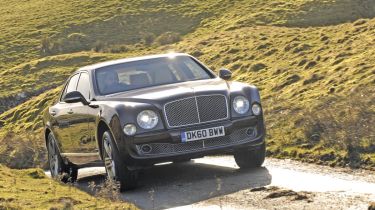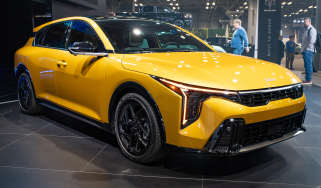Bentley Mulsanne
We take new big saloon back to its roots on a 170-mile trip through Bentley’s 92-year history
Building a Bentley isn’t the work of a moment. While most modern mass-produced cars fire out of the factory gates every few seconds, these bespoke British machines can take months of painstaking construction.
This handcrafted care and attention is part of the brand’s appeal – and has kept it going through 92 years of often turbulent history. It’s also the reason we’re at Bentley’s home in Crewe, Cheshire. We want to get under the marque’s skin, and witness the journey its cars undertake – from bare metal panels to a fully completed four-wheel masterpiece.
But before we get started on the production line, there’s the small matter of the 168-mile trip from Auto Express’ London office. We’ve planned a couple of stops along the way that help tell the firm’s story – from its humble 1919 beginnings to its current position as maker of some of the world’s most luxurious cars. Fortunately, we’ve got the ideal companion for the journey: a Bentley Mulsanne.
The imposing four-door made its debut last year, and is the first big Bentley saloon in nearly 80 years which hasn’t had to use mechanical hand-me-downs from former owner Rolls-Royce. As a result, it promises to deliver an undiluted hit of Bentley spirit.
Used - available now

2022 Nissan
Micra
22,169 milesManualPetrol1.0L
Cash £10,700
2015 Volvo
S60
78,200 milesManualPetrol1.6L
Cash £7,400
2016 Tesla
Model S
78,000 milesAutomaticElectric
Cash £18,999
2019 Nissan
Micra
17,450 milesAutomaticPetrol1.0L
Cash £13,199At nearly six metres long and more than two metres wide, you’d expect the mighty Mulsanne to be intimidating to drive on the capital’s crowded streets. But it immediately inspires confidence, with the high-set driving position and excellent visibility allowing us to make light work of the morning rush hour.
Our first stop is only a few miles away in Cricklewood, north London. Oxgate Lane is the site of WO Bentley’s first factory – he moved here in 1920 after outgrowing his cramped workshop at New Street Mews, in central London.
With the financial backing of rich playboy Woolf Barnato, the company went from strength to strength, and over a period of 10 years it became synonymous with power and speed, winning the Le Mans 24 Hours on four occasions.
Today, there’s nothing to link Oxgate Lane with Bentley. Standing on the old factory site is a grimy industrial estate, packed with crumbling brick buildings, greasy spoon cafés and small workshops overflowing with bangers in various states of disrepair. Our £220,000 Bentley stands out like a sore thumb. So we take a couple of snaps and hit the road.
We point the Mulsanne north up the M1, punching the city of Derby into the sat-nav. This is where the next stage of Bentley’s story takes place. Despite its success on the track, by the late Twenties the firm’s finances were in tatters, as the Depression brought WO to his knees. In 1931 he accepted defeat, selling to arch- rival Rolls-Royce and moving operations to the new owner’s premises in Derby.
Free-flowing motorway traffic allows us to make good time. The Mulsanne laps up this sort of journey, wafting along in near silence and incredible comfort, its eight-speed gearbox shifting seamlessly. The 6.75-litre twin-turbo V8 delivers effortless thrust, thanks to its monumental 1,025Nm torque output.
As we’re ahead of schedule, we take a detour to the Derbyshire Dales. Despite their size and luxury, Bentleys have always been drivers’ cars, with wealthy owners preferring to sit at the wheel, rather than behind a chauffeur. We want to see if the Mulsanne upholds this reputation – and where better to test it than on the twisting and undulating tarmac in this pretty part of the world?
Many of the roads are barely wider than the Bentley, yet you never feel overawed. Swift steering, strong grip and incredible poise make it remarkably agile. And with the adaptive dampers set to Sport, the big Brit is as much fun as a hot hatch. We’re enjoying ourselves so much that we lose track of time, and it’s dark when we arrive in Derby.
The Nightingale Road factory is eerie at this time of night. With boarded-up windows and an overgrown car park, it looks a world away from the bustling site you see in period black and white photographs. Bentleys rolled off the lines here from 1931 to 1946, before Rolls moved car production to Crewe. The site was then given over to aero engines, but was finally abandoned in 2008. With our pictures taken, we climb back aboard the Mulsanne and head for our overnight stop.
Bright and early the next morning, we’re at Bentley’s Crewe plant, eager for a glimpse behind the scenes at one of the world’s most exclusive car manufacturers. We’re greeted in the classy reception area by Mulsanne project leader Ashley Wickham and factory guide Nigel Lofkin.
First stop is the body-in-white hall, where Mulsanne bodyshells are built up from bare metal panels. There are a few robots here, but a lot of the work is still done by hand. “Each bodyshell takes around 100 man hours to complete,” shouts Ashley over the clatter of hammers and crackle of welders. “The robots do repetitive precision tasks, but when brazing on the roof panel, for instance, there’s no substitute for craftsmanship.”
At the end of the line, completed shells are checked for imperfections. It’s a testament to the skill of Bentley staff that our untrained eyes and fingers can detect nothing wrong with the areas of metal that have been marked up to be rectified.
From here, the cars go for a lick of paint. But we head to the wood shop – where the Mulsanne’s veneer interior trim is created by manager Dave Mattocks’ team of craftsmen.
The fragrant smell of wood fills our nostrils as we see blocks of timber and fragile veneers transformed into the rich, lustrous trim that fills much of the Mulsanne’s cabin. Some of the complex shapes are machine cut, but once again it’s humans who do most of the work. “We craft the veneers exactly as we did in the Thirties,” explains Dave. “A lot of this work simply can’t be done by machines.”
It’s a similar story with the soft leather that covers the seats. “We mainly use hides from Scandinavia and southern Germany, as cows from there don’t tend to suffer from insect bites and barbed wire cuts,” says Nigel, who worked here in the trim shop before becoming a factory guide. “We still rely on the human eye to check for imperfections in the leather.”
Around 17 separate hides are used to trim a Mulsanne interior, each one cut and stitched by hand. And to give you an idea of exactly how labour intensive this process is, the winged Bentley badge embossed in each seat requires more than 5,000 stitches!
In the trim shop we meet Kath Green, who spends her day upholstering leather steering wheels for the Mulsanne. “A standard one takes about three and half hours,” she explains. “However, the heated one I’m doing at the moment will take around five and half hours.”
As ever with handcrafted cars, there are a number of quirks in the production process. For instance, Kath’s colleague Keith uses a table fork to mark out the spacing for the stitching on the steering wheels he makes! Next we head to the engine plant, where the Mulsanne’s V8 is put together. And as we’ve come to expect, the hi-tech mixes seamlessly with the handmade once again.
The all-new unit has variable valve timing and a clever function allowing it to run on four cylinders to cut fuel use and emissions. However, all this cutting-edge kit is pieced together by hand – with the six-stage build taking around nine hours.
Our tour ends in the relaxing surroundings of the Mulliner Gallery. Here, lucky Mulsanne customers get to choose from the 118 paint colours, 24 leather finishes and various veneers Bentley offers. One of our favourites is Glacier Blue. “That was created by one of our clients,” says Nigel. “He couldn’t find anything he liked in our colour palette, so he brought in the food mixer from his kitchen! We matched the light blue finish – and it looked so good that it became part of the line-up.”
Such attention to detail sums up the Bentley experience. When WO started out all those years ago, he had one simple aim: “To build a good car, a fast car, the best in class.” Our time with the Mulsanne and visit to Crewe show this goal has been achieved.







